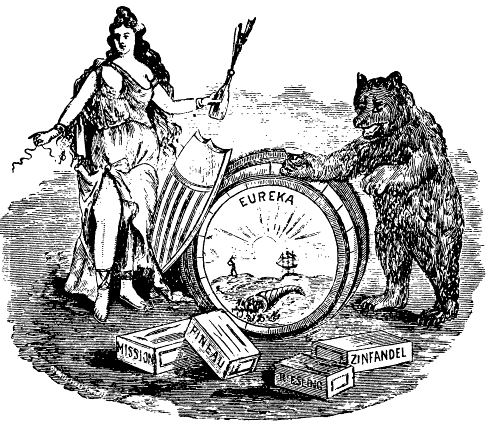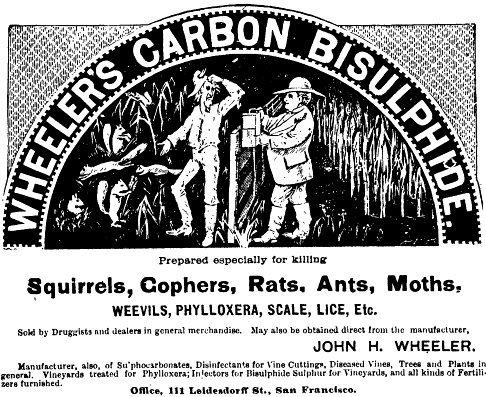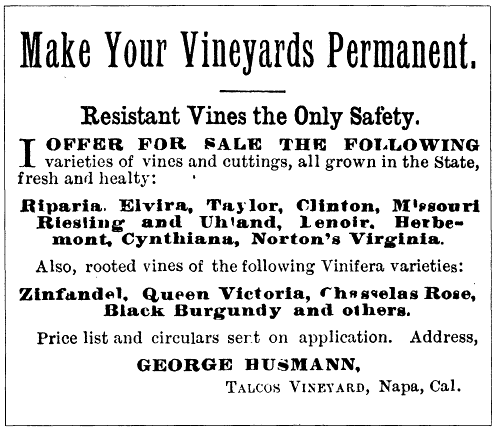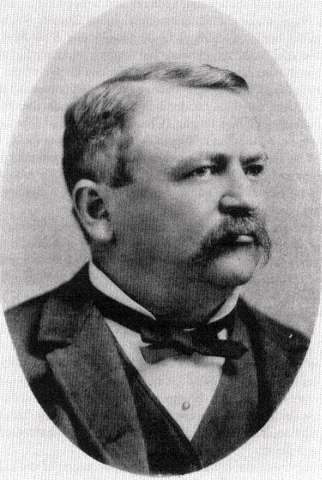Organizations and State Support: the Board of State Viticultural Commissioners
The earliest organizations of winegrowers in California were essentially ad hoc , the hoc almost invariably being
some question of taxes or tariffs. The first such group was formed at the end of 1862 as the "California Wine-Growers' Association"; its objects included general "encouragement" to the industry and "discouragement" of the adulterating of California wines, but its real business was to protest a new federal tax on domestic wine and to ask for tariff protection against imported wine. After its first flurry of activity, the association quickly languished, and it was dead within a year.[1] It was galvanized back to life in 1866 by the renewed threat of a tax on domestic wine. The association sent a lobbyist to Washington and, whether for that reason or not, the tax bill did not pass.[2] A satellite group in Los Angeles was also created in 1866; this had life enough in it to survive through at least the next three years, for it met in 1869 to protest against new regulations for the collection of taxes.[3]
In 1872 another and more sustained effort to establish a statewide society began with the creation of the cumbersomely named California Vine Growers' and Wine and Brandy Manufacturers' Association. B. D. Wilson, of the Lake Vineyard in the San Gabriel Valley, was president, the headquarters were in Sacramento, and the state gave the society official recognition by a grant of $1,000.[4] The society—its name soon shortened to a tolerable length as the California State Vinicultural Society—was more than a protest group: it held an annual fair, set up a committee on the cultivation of the vine, and called its officers to regular meetings.[5] But its
activity was most notable when it came to the old questions of taxes and tariffs. A sharp flurry broke out in 1878 when the French proposed a trade treaty with the United States and the Californians took alarm: preferential treatment for French wines would spell doom for them, they argued through the society, and meetings of protest were held up and down the state.[6]
There were also local bodies of growers and winemakers organized in counties that had established a viticultural industry. A "Grape-Growers' Association" was formed by the farmers of Napa, Solano, and Sonoma counties as early as 1870. The Santa Clara growers also organized early.[7] But these were groups whose work was strictly local and largely devoted to the technical problems of production.
The pressure of demand for an official body to direct and assist the California wine industry as a whole grew intense towards the end of 1879. The crop had been short that year, sending prices up. At the same time, when the prospects of wine-growing in Europe looked hopelessly bleak owing to the ravages of phylloxera, the future of California as winegrower to the world looked more glamorous than had ever been imagined before. The feeling of the period is conveyed in this prophecy by the respected grower and winemaker H. W. Crabb, proprietor of the To Kalon Vineyard in Rutherford, Napa County:
Whoever lives a half a century hence, will find the grapes of California in every city of the Union; her raisins supplying the whole Western hemisphere; her wines in every mart of the globe, and then, with her golden shores, her sunny clime, her vine-clad hills and plains, will California, indeed, be the Vineland of the world.[8]
The economic possibilities of wine took on a new attractiveness in the light of this vision, and politicians began to listen to the promoters. There had been a Commit tee on the Culture of the Grapevine in the state assembly since 1861; it now began to take information from winegrowers and dealers such as Arpad Haraszthy, son of Agoston and to some extent his father's heir as the leading publicist for California wines; from scientists like Hilgard; from established producers like Krug and De Turk; and from bodies such as the California State Agricultural Society. The up shot was the passage of a bill on 15 April 1880 creating a Board of State Viticultural Commissioners.[9]
The board, which had the very general charge to "promote the viticultural in dustries of the state," consisted of nine commissioners, one for each of the seven districts into which the state was divided[10] and two for the state at large; the president was selected from among the commissioners, and all served without pay. The prestige of the board was established at once by the original commissioners appointed, for they were all men of high standing in the industry. Arpad Haraszthy was the first president, and his fellow commissioners included Charles Krug, Isaac De Turk, George West, L. J. Rose, and J. De Barth Shorb. The executive officers, who were paid, included a secretary, and, after modification of the original act in 1881, a chief executive officer.

95
California's rising confidence as a winegrowing region is illustrated by this ebullient
frontispiece to E. H. Rixford's The Wine Press and the Cellar (San Francisco, 1883). The
figure of Liberty pops a cork while the California bear holds his glass to be filled on a
barrel whose head displays the state seal. Cases of mission, "pineau," riesling, and zinfandel
wine fill the foreground. Rixford, a San Francisco lawyer, had just purchased vineyard property
in San Mateo County. His book was evidently the fruit of his study in preparation for
becoming a winegrower. The wines that he afterwards produced at his La Questa Vineyard,
particularly the cabernet, acquired a high reputation. (California State University, Fresno, Library)
The first urgent business of the board was to meet the problem of phylloxera. The insect had been discovered as early as 1873 in California, in a vineyard near the town of Sonoma.[11] For some reason the winged form of the insect did not regularly develop in California, and so its spread was relatively slow. By 1880, how ever, growers had to face the fact that they were in serious trouble from phylloxera: some 600 acres of vines had already been destroyed in Sonoma County,[12] and infestations had been found in every other winegrowing region of the state except Los Angeles. For years growers in the afflicted regions had pretended that the

96
An advertisement for carbon bisulphide as, among other things, a specific against phylloxera.
John H. Wheeler was the first secretary of the Board of State Viticultural Commissioners, and
the address given in this advertisement is that of the board. Since the board was then en gaged
in a search for a remedy for phylloxera, Wheeler's use of his official position for com mercial
purposes seems highly irregular. But no one seems to have complained. ( Pacific Rural
Press , December 1881)
threat was not serious, or that it was under control, or that it did not exist, or that it would go away by itself. But the time had come when such pretense could no longer be kept up. Now the board acted vigorously. It surveyed the infested areas; it made and published translations of the standard French treatises on reconstituting vineyards after phylloxera attack; it tested the innumerable "remedies" that had been hopefully proposed since the outbreak of the disease in France in 1863.[13] In a very few years, after some dallying with the attractions of carbon bisulphide as a cheap and ready remedy, the board was able to make clear and positive recommendations to California growers. Resistant rootstocks of native American varieties were the only sound solution, just as they were in Europe. In fairness, it should be noted that the University of California experts had earlier come to the same con clusion, so that the board was in effect endorsing a finding made by the univer-
sity.[14] This was one of several issues in which duplicated work by board and university created jealousies.
Many, perhaps most, vineyardists in California were slow or negligent in acting on the advice given by board and university alike. Fewer than 2,000 acres, it was estimated, had been replanted to resistant rootstock by 1888, while phylloxera continued to spread.[15] In Napa County, for example, even after clear evidence had been provided both of the destructiveness of the affliction and of the certainty of the remedy, one writer estimates that 10,000 acres were destroyed by phylloxera between 1889 and 1892. By 1900 there were only 2,000 bearing acres in Napa, and though the recovery was rapid thereafter, the statistics are interesting evidence of how slow growers were to respond even when they must have known what awaited them if they did nothing.[16]
It was not, however, merely human stubbornness or parsimony that slowed the fight against phylloxera. Though the solution was known in general, much re mained to be learned about what resistant native stocks should be used, and how they should be matched to varieties and soils. Wetmore and others, without much evidence, recommended the native V. californica , but results over a period of years showed this to be a mistake.[17] Later, growers thought Lenoir could be indiscriminately used, and then Rupestris St. George. Finally, California appealed to the U.S. Department of Agriculture, which undertook a program of systematic testing up and down the state, beginning in 1904. The scientist in charge of this work was George C. Husmann, the son of the Missouri pioneer grower George Husmann. How large and difficult the problem to be met was, and how slowly the recovery proceeded, appears from the younger Husmann's report in 1915: at least 250,000 acres of vines had been lost in the preceding decades; worse, only a few had been replanted in the past ten years, and of those, many were still not planted on re sistant rootstock.[18]
Though the phylloxera question was the most difficult of the technical questions faced by the Board of State Viticultural Commissioners, their work touched on a number of other things too. It included an extensive program of publication, mostly in translations from the French on such topics as pruning, training, and grafting, and on cellar practices and techniques of vinification; original American contributions on such matters were still rare, though Charles Wetmore did publish a short ampelography (as the scientific description of vines is called) of California for the board.[19] The board opened an experimental cellar in San Francisco in 1886, where tests with different varieties and methods could be made, including experiments with brandy making; and in 1887 it made arrangements for an experimental vineyard in Napa County.[20] The question of varietal selection was given particular attention, as were the related matters of varietal identification and nomenclature—all questions of first importance in California. The board also studied such subjects as the soils and climates of California regions, and advised on the choice of sites.[21]
The board's work towards identifying superior varieties for California and en couraging their planting throws an interesting light on the state of things in the

97
George Husmann had been brought from Missouri to California to help save the state's vineyards
from the ravages of phylloxera, but his words of wisdom contained in this advertise ment went
unheeded by California vineyardists: "Resistant Vines the Only Safety." Husmann had supplied
the French with large quantities of resistant rootstocks from Missouri in their fight against the
phylloxera and knew what he was talking about. But by the turn of the century the vineyards of
northern California, which might have been made se cure, were largely devastated. ( Pacific
Rural Press , 29 December 1883)
early 1880s. We have already seen how French and German growers in the 1850s brought in the major varieties of vinifera; but very few of these, it appears, took hold commercially at the time. Zinfandel caught on in the Bay Area counties, but did not displace the Mission; and the superior white wine varieties seem not to have succeeded at all. The evidence of the trade press and of the exhibitions and wine judgings in the early 1880s is that the Mission remained the dominant variety; Zinfandel was the uncontested leader among grapes regarded as producing fine red wines, and for the whites the Gutedel (Chasselas) was the variety of choice; there was also some of a variety called Riesling, but whether authentic Riesling or not is doubtful, for many varieties have masqueraded under that name.[22]
Comments by two of the leading growers and winemakers, one from Sonoma and one from Napa, make the situation clear. Julius Dresel, writing in 1880 for George Husmann's book on American Grape Growing and Wine-Making , stated that the Riesling, Gutedel, and Burger were the leading varieties for white wine; for red, there was only the Zinfandel. H. W. Crabb, the owner of the celebrated To Kalon Vineyard in Napa County and a man who had experimented for years with a vast range of vinifera varieties, affirmed in the same work that the prime white varieties were Riesling, White Pineau (Chenin Blanc?), and Chasselas (Gutedel); as for red wines, he added Black Burgundy (perhaps Pinot Noir) and Charbono to Zinfandel.[23] The varieties that Dresel named were undoubtedly far more familiar than those named by Crabb, but the lists given by both men are notable for the varieties that they fail to name—Cabernet, Syrah, Chardonnay, Semillon, Sauvignon Blanc, and so on.
A few skilled growers—Pierre Pellier and Charles Lefranc in Santa Clara County were notable instances—succeeded in keeping some noble varieties in cultivation. But when Charles Wetmore, as chief executive viticultural officer of the board, reported in 1884 on the state's vineyards, he did not have a very advanced condition of affairs to describe. Not "a single bearing vineyard," he wrote, was "planted systematically with the varieties necessary to reproduce the types of Bordeaux clarets, Burgundies, Sauternes, Hermitage, Portuguese port, Spanish sherry, Madeira, or Cognac."[24] Cabernet, for example, was "only experimentally known here at present"; Pinot Noir was not yet cultivated "in any quantity sufficient to give token of its merits in this State"; Chardonnay was "not practically known to us." Wetmore himself had recently imported Semillon vines but had none for distribution; as for the true sherry varieties, he observed, they "are practically unknown to us, although during the last year some stocks have been imported for trial."[25] And so it went.
Wetmore attributed the failure of earlier importations of the noble varieties to the old Spanish tradition of short pruning—good for heavy-bearing varieties but not for the shy-bearing fine varieties. The early growers, finding that their methods did not succeed with the noble varieties, abandoned them and went back to their proven varieties. But now, in the eighties, the prospects were rapidly changing, and Wetmore wrote with confidence in the future. For one thing, there was a consider able list of experiment with superior varieties: Malbec, Frontignan, Verdelho, Cabernet Sauvignon, Petite Syrah, and Semillon are among those that Wetmore names.[26] And for another, the plantings made since the founding of the board had vastly extended the stock of superior varieties actually available: Wetmore estimated that in four years the state's acreage had tripled, and that most of the in crease was accounted for by varieties better than those already growing in California vineyards.[27]
Wetmore's optimism was not wholly mistaken. A decade later, on the occasion of the great Columbian Exposition in Chicago in 1893, the display of California wines showed that many of the varieties practically unknown in 1880 were now

98
Charles A. Wetmore (1847-1927), journalist, speculator, and winemaker.
the founder of Cresta Blanca Winery, was the most energetic and effective
member of the Board of State Viticultural Commissioners in the first and
most useful decade of its life. (Bancroft Library, University of California)
assimilated into the repertory of the state's production. The varietals exhibited there included Riesling, Semillon, Cabernet, Barbera, Malbec, and Carignane—though still no Chardonnay. The same exhibit also included such astonishing names as a "Chambertin" from J. Gundlach, a "Hermitage" from H. W. Crabb, and a "Chateau Yquem" from Wetmore himself; one may hope that these were made in part at least from Pinot Noir, Petite Syrah, and Semillon. All of those varieties were established in the state by that time.[28]
Carrying out experiments, collecting scientific information, and spreading it to the members of the industry may be thought of as the board's internal affairs. The
external affairs lay largely in political and promotional work. The board kept an eye on legislation at both the state and national level, especially on anything that bore on the touchy question of taxation, and took a hand where it could in trying to affect the process of lawmaking. But more and more, as the years passed, the work of the board tended to concentrate on promoting California wine. After the collapse of the market in the late eighties, this was clearly its main job. From the beginning, the board was responsible for an annual state viticultural convention, which was officially intended to be a means for organizing and instructing wine-growers throughout the state, but which had perhaps the even more important function of advertising the winemaking industry widely and regularly. The board also took responsibility for seeing that California wine was represented at inter national fairs and exhibits—for example, at Antwerp and Louisville in 1885, at London in 1887, Paris in 1889, and Bordeaux in 1895.[29]
The Chicago Columbian Exposition of 1893 has already been mentioned. This was far and away the most splendid American fair held during the active years of the board, and the Californians had high hopes for promoting their wines through the Exposition. They were disappointed. The arrangements for the display of wines were confused; the concession for selling wine went to a man who bought French wine cheaply and prohibited the sale of the California article, and the wine judging satisfied no one. The French withdrew their wine exhibit in anger over the qualification of the jurors, and the matter was settled only by the absurd expedient of giving awards to all of the exhibitors, as in the caucus race in Alice in Wonderland .[30]
Next year there was a major fair on the Californians' home ground, the Mid winter Exposition in San Francisco, and here things went better. At the Midwinter Exposition the California winemakers erected a "Palace" adorned with plaster statues of Bacchus and Mercury, with an abundance of roccoco twiddles and scallops in plaster, and with tags and verses from a variety of sources and languages: "Hail, California, glory to thee! / Nature's great wonder, noble and free" was one; Martin Luther's "Wer nicht liebt Wein, Weib und Gesang, / Der bleibt ein Narr sein Leben lang" another. Here there were displays of some fifty-two winemakers and merchants, and visitors could sample the wines on display in a Weinstube adjoining the Palace. The rules for the wine judging were written by Arpad Haraszthy, and on these terms prizes went to some of the best of California's producers. If the fair did not extend the fame of the exhibitors as the grand show at Chicago might have done, it at least helped to smooth some ruffled feelings.[31]
Two other promotional schemes sponsored by the board may be mentioned. In 1888 it opened a permanent exhibition of California wine in connection with a cafe in downtown San Francisco. The cafe menu offered such exotica as "concombres à la Charles Krug," "pieds de mouton à la Olivina," and "anchois à l'huile de Kohler and Frohling," as well as a choice of any of the wines displayed in the permanent exhibition; they could be drunk with the meal (and what, one wonders, went with the anchovies?) or taken home in any quantity.[32] At the other end of the country, the board hired the celebrated American actress, journalist, and lecturer Kate
Field, the friend of Robert Browning and Anthony Trollope, to give a lecture on California wine in the cities of the East Coast. This she did in the season of 1889, with mixed results. She ran afoul of the temperance movement, already strongly established in this country, and though the board expressed satisfaction with her effort, the arrangement was not continued.[33]
From its founding in 1880 the board's dominating member was Charles Wet-more, one of the first graduates of the University of California, a San Francisco journalist, and a restless, tactless, enterprising man of considerable talent and great confidence.[34] Arpad Haraszthy was president of the board for the first eight years of its existence, but the energy behind most of its activities came from Wetmore. He was one of the original commissioners, representing the county of Napa; when the office of chief executive officer was created in 1881, Wetmore stepped into the position and held it for the next six years. It was he who directed the surveys, collected the statistics, translated European technical treatises, arranged for publication of the board's reports and instructions, set the research policies of the board, and supervised its experiments. He travelled up and down the state to address meetings and inspect vineyards; he lobbied in Washington, publicized and promoted in New York, represented California wine at expositions. And all the time he poured out an inexhaustible flood of articles on every subject connected with grapes and wine in California, both technical and popular. In the eighties he was virtually synonymous with California wine to the public.
He did not do all this without stepping on toes, for he was quick to take the initiative against what he saw as obstructions and enemies. He resigned as chief executive officer in 1887, but remained a commissioner; a year later he became president of the board; in the next year, 1889, he became chief executive officer again, adding the title to that of the presidency. Though his presidency ended in 1890, he remained chief executive until 1891, when his connection with the board ceased.[35] It is probably more than a coincidence that the energetic days of the board ended with Wetmore's departure. But the Wetmore connection was not yet broken, for Charles's brother Clarence, who had also served the board in various ways, succeeded as chief executive.[36] Charles Wetmore is now best remembered as the founder of the original Cresta Blanca Winery in the Livermore Valley in 1882; he should also be remembered for his vital part in the operation of the Viticultural Commission in the first ten years, the effective decade of the board's work.